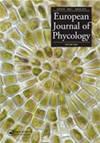Biodiversity of Tehran freshwater cyanobacteria and remote sensing analysis of reservoirs
IF 1.7
4区 生物学
Q2 MARINE & FRESHWATER BIOLOGY
引用次数: 0
Abstract
ABSTRACTAnalysis of cyanobacterial diversity is an important step towards identifying new biological resources for production of bioactive compounds. In this study cyanobacterial surface coverage was assessed through satellite image analysis of Tehran drinking water reservoirs in late summer and early autumn of 2018. We also analysed freshwater cyanobacteria including seven local strains purified from surface water samples. Following a polyphasic taxonomic approach combining morphological and molecular methods the culturable strains were classified into Synechococcales and Oscillatoriales, representing at least three families and four genera. Similarity-based analysis of their partial 16S rRNA genes showed 93.4–97.0% sequence identity among the strains from different ecosystems. Considering 95–96% as the overall cut-off for discriminating bacterial species, strains UTMC6011 and UTMC6013 are likely to be new species. Physiological characterization of the new strains and nine others isolated previously by our group from another freshwater ecosystem led to identification of seven nitrogen-fixing, 11 sulphide-tolerant, three salt-tolerant and three heterotrophic strains. Further taxonomic analyses are needed to support investigation of their biotechnological potential.Highlights The biodiversity and physiology of cyanobacteria in the main drinking water reservoirs of the megacity, Tehran, were studied by remote sensing and sample analysis.Seven cyanobacterial strains were isolated from the two freshwater lakes. Similarity-based analysis of obtained 16S rRNA gene sequence showed 93.4–97.0% sequence similarity with the strains from other ecosystems.Cyanobacterial isolates of these freshwater reservoirs included seven N2-fixing, 11 sulphide-tolerant, three salt-tolerant and three heterotrophic strains.KEYWORDS: Biodiversityfreshwater cyanobacteriafreshwater reservoir ecosystemphylogenypolyphasic approachremote sensing AcknowledgementsThe authors would like to thank Prof. Alexander V. Pinevich, Dr Svetlana G. Averina and Dr Olga Gavrilova for their valuable comments related to the isolation and morphological studies of cyanobacterial strains.Disclosure statementThe authors state the absence of any competing interests.Supplementary materialThe following supplementary material is accessible via the Supplementary Content tab on the article’s online page at https://doi.org/10.1080/09670262.2023.2261113.Supplementary fig. S1 Phylogenetic tree constructed based on 16S rDNA partial sequences. Obtained sequences aligned and phylogenetic tree constructed using ClustalW and MEGA7 softwares, respectively. 55 cyanobacterial sequences were included and three species of Chloroflexus were used as outgroups. A Maximum likelihood algorithm involving 1000 times boot-strap analyses was performed. Asterisks show strains isolated from Tehran freshwaters. * the isolated strains in this study.Supplementary table S1. Main characteristics of Tehran dams.Supplementary table S2. Measured values of water quality parameters and cyanobacteria concentration in one ml of samples.Supplementary table S3. Morphometric characteristics of isolated cyanobacteria in this study.Supplementary table S4. The physiological characteristics of cyanobacterial strains of Tehran dams. (+) growth, (-) lack of growth.Authors contributionsY. Tavakoli: Sampling, lab experiments and drafting the manuscript; F. Mohammadipanah: Conceptualization and revising the paper; S. Hamzeh: Remote sensing analysis; A. Sedighi: Remote sensing analysis.Additional informationFundingThis research was partially funded by Iran National Science Foundation and University of Tehran.德黑兰淡水蓝藻生物多样性及水库遥感分析
摘要蓝藻多样性分析是寻找新的生物资源以生产生物活性化合物的重要一步。在本研究中,通过对2018年夏末秋初德黑兰饮用水水库的卫星图像分析,评估了蓝藻表面覆盖率。我们还分析了淡水蓝藻,包括从地表水样品中纯化的7种当地菌株。采用形态与分子相结合的多相分类学方法,将可培养菌株分为聚球菌科和振荡球菌科,至少隶属于3科4属。基于相似性分析的16S rRNA部分基因序列在不同生态系统菌株间的同源性为93.4 ~ 97.0%。考虑到95-96%的总体分界点是细菌种类的区分,菌株UTMC6011和UTMC6013很可能是新种。通过对新菌株和本课课组先前从另一个淡水生态系统中分离的9株菌株的生理特性分析,鉴定出7株固氮菌株、11株耐硫化物菌株、3株耐盐菌株和3株异养菌株。需要进一步的分类分析来支持对其生物技术潜力的调查。通过遥感和样本分析,对特大城市德黑兰主要饮用水水库中蓝藻的生物多样性和生理特征进行了研究。从两个淡水湖中分离出7株蓝藻菌株。对获得的16S rRNA基因序列进行相似性分析,与其他生态系统菌株的序列相似性为93.4 ~ 97.0%。这些淡水水库分离的蓝藻菌株包括7株固氮菌株、11株耐硫化物菌株、3株耐盐菌株和3株异养菌株。作者感谢Alexander V. Pinevich教授、Svetlana G. Averina博士和Olga Gavrilova博士对蓝藻菌株的分离和形态学研究提出的宝贵意见。披露声明作者声明没有任何利益冲突。以下补充材料可通过文章在线页面https://doi.org/10.1080/09670262.2023.2261113.Supplementary上的补充内容选项卡访问。图S1基于16S rDNA部分序列构建的系统发育树。分别使用ClustalW和MEGA7软件进行序列比对和系统发育树构建。共纳入55个蓝藻序列,并以3种绿藻作为外群。最大似然算法涉及1000次靴带分析。星号表示从德黑兰淡水中分离出的菌株。*本研究中分离的菌株。补充表S1。德黑兰大坝的主要特点。补充表S2。测量一毫升样品中水质参数和蓝藻浓度的值。补充表S3。本研究中分离蓝藻的形态计量学特征。补充表S4。德黑兰大坝蓝藻菌株的生理特性。(+)增长,(-)缺乏增长。作者contributionsY。Tavakoli:取样,实验室实验和起草手稿;F. Mohammadipanah:概念化和修改论文;S. Hamzeh:遥感分析;A. Sedighi:遥感分析。本研究部分由伊朗国家科学基金会和德黑兰大学资助。
本文章由计算机程序翻译,如有差异,请以英文原文为准。
求助全文
约1分钟内获得全文
求助全文
来源期刊

European Journal of Phycology
生物-海洋与淡水生物学
CiteScore
4.80
自引率
4.20%
发文量
37
审稿时长
>12 weeks
期刊介绍:
The European Journal of Phycology is an important focus for the activities of algal researchers all over the world. The Editors-in-Chief are assisted by an international team of Associate Editors who are experts in the following fields: macroalgal ecology, microalgal ecology, physiology and biochemistry, cell biology, molecular biology, macroalgal and microalgal systematics, applied phycology and biotechnology. The European Journal of Phycology publishes papers on all aspects of algae, including cyanobacteria. Articles may be in the form of primary research papers and reviews of topical subjects.
The journal publishes high quality research and is well cited, with a consistently good Impact Factor.
 求助内容:
求助内容: 应助结果提醒方式:
应助结果提醒方式:


